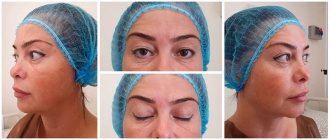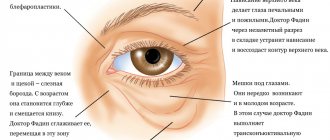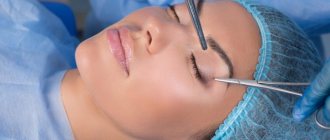Blepharoplasty is a method of correcting the shape of the upper or lower eyelids, as well as the shape of the eye itself. It is considered one of the most difficult plastic procedures.
Blepharoplasty in Korea is characterized by excellent results and a low risk of possible complications, thanks to the highly qualified specialists in this country.
This type of surgery is used to eliminate certain aesthetic defects: bags under the eyes, drooping upper eyelids, bulging eyes, and others. Also, with the help of blepharoplasty, you can get rid of the epicanthus, a fold at the inner corner of the eye, characteristic of people of the Asian race.
The cost of blepharoplasty in Korea is calculated individually, depending on the condition of the patient’s skin and the structure of his eyes.
Blepharoplasty in Korea
Blepharoplasty is an operation to change the shape of the eyelids and the shape of the eyes. A very popular operation, especially among the female population. With blepharoplasty in Korea
You can remove bags under the eyes, dark circles and tighten your skin. This type of surgery involves excision of excess skin and fatty formations.
Indications for eyelid surgery
- Overhang of the skin of the upper eyelid on the area of the upper eyelashes
- No upper eyelid crease
- Deep or numerous fine wrinkles in the lower eyelids
- Impaired vision due to drooping upper eyelid
- Bags under the eyes
- Excess skin of the lower eyelids
- Changing the shape and shape of the eyes
Types of blepharoplasty
1) Correction of the upper eyelid eliminates sagging
2) Correction of the lower eyelids helps get rid of bags under the eyes, swelling and hernias
3) Circular blepharoplasty
4) Correction of Asian eye shape (creating a double eyelid)
5) Changing the angles of the eyes (canthopexy)
6) Transconjunctival blepharoplasty – removal of fat deposits.
Upper eyelid blepharoplasty
With this intervention, excess skin, fat and muscle tissue are eliminated. The operation is performed under local anesthesia, but in some cases, at the request of the patient, general anesthesia is used. The procedure takes 60-90 minutes. During upper eyelid correction, the surgeon makes an incision in the natural crease, which avoids visible scars. Elimination of drooping eyelid folds can also be carried out using a laser, then no incisions are made, and the rehabilitation period is reduced to several days.
Due to the oriental structure of the eyes, blepharoplasty in Korea
very popular (changing the shape and shape of the eyes).
After manipulation, the skin becomes smooth, the look seems clear and open. This operation refreshes the face and erases visible signs of aging. With the correct actions of a specialist, the result will please you for more than 10 years.
After manipulation, the skin becomes smooth, the look seems clear and open. This operation refreshes the face and erases visible signs of aging.
The day after surgery, the patient must come to the clinic for examination. The sutures are removed on the 5th-6th day.
Lower eyelid blepharoplasty
Correction of the lower eyelid lasts 1-1.5 hours. The intervention is performed using general or local anesthesia. To perform the operation, the skin is incised along the eyelash line. The wound is sutured with intradermal sutures, resulting in a good aesthetic result.
In some cases, manipulation is performed through a transconjunctival incision (on the mucous membrane under the eyelid). In this way, small excess fat tissue can be removed. The method is used for unexpressed age-related changes. The resulting result improves your appearance for a long time and gives you a feeling of youth and attractiveness.
With the help of lower eyelid blepharoplasty, South Korean specialists achieve:
- eye contour correction;
- improving the properties of the skin under the eyes;
- changes in the shape and size of the eyelids;
- eliminating excess skin and fat;
- correction of hollows under the eyes.
Circular blepharoplasty
This is a simultaneous plastic surgery of the upper and lower eyelids. In one operation, you can get rid of several problems at once (wrinkles, sagging skin, fat bags). It is performed surgically, suturelessly or using a laser.
Recovery after blepharoplasty
Immediately after surgery, the eyes become swollen and bruised. To reduce these unwanted effects, after suturing your eyes, you will need to apply cold compresses and follow all the doctor's recommendations.
The day after eyelid surgery, the surgical wound is examined. The sutures are removed 5-7 days after the intervention.
After a recovery period of 5-6 weeks, the patient’s face looks completely natural, and postoperative stitches are not visible.
It is very difficult to choose a Plastic Surgery clinic among all the abundance. Ours offers you free assistance in choosing a clinic, organizing and preparing a trip to Korea.
Blepharoplasty in Korea is:
- assistance from highly qualified specialists;
- affordable prices;
- high level of service;
- short rehabilitation period;
- exactly the expected aesthetic result.
Approximate cost of plastic surgery procedures in Korea
| Type of operation | $ | being in Korea |
| Eyelid surgery (creating a double eyelid) | from 1,500 | 7 days |
| Blepharoplasty | from 2,000 | 7-10 days |
If you have not found the information you need or would like advice, please contact us. Our consultation and requests to clinics are all free.
about blepharoplasty in Korea
Blepharoptosis (drooping of the lower eyelid) – Blepharoplasty: treatment in the best clinics in South Korea
Blepharoplasty is considered the “calling card” of facial plastic surgery in South Korea. Plastic surgery is one of the areas in which Korean specialists have achieved unprecedented success. Thanks to the vast experience of plastic surgeons, a competent approach and the use of modern robotic systems, the medical staff guarantees an excellent result, which has no equal in the whole world.
Indications for blepharoplasty in Korea
Blepharoplasty is a plastic surgery operation whose purpose is to correct the periocular area. The procedure allows you to restore the youth and beauty of your face in a short time.
Indications for this type of plastic surgery may include:
- Blepharoptosis (abnormal drooping of the eyelid)
- Drooping eyelids due to excess skin
- Excess fat deposits under the eyes in the form of bags
- Wrinkles around the eyes
- Eye asymmetry
- Correction of the shape or shape of the eyes
- Scars due to injury
- Individual anatomical features
Consultation with a plastic surgeon and diagnostics in Korea
The blepharoplasty procedure in most cases is purely aesthetic and minimally invasive, and therefore does not require special preparation. However, patients must undergo a preliminary consultation with a plastic surgeon and certain diagnostic measures, which include:
- Taking an anamnesis – assessing the patient’s wishes and the possibilities of performing the operation. During the history taking process, the plastic surgeon also informs the patient about the stages and techniques of blepharoplasty.
- Modeling the desired result - in Korean clinics, preliminary visualization of the results of the operation is carried out using special computer programs. Photographs are also taken to evaluate the results after the procedure.
- Ophthalmological examination - determination by an ophthalmologist of the individual structural features of the eye structures in order to draw up a surgical plan.
- Laboratory examinations – general and biochemical tests to assess the patient’s health indicators and exclude contraindications.
- Consultation with an anesthesiologist - choosing a method of drug pain relief during surgery.
Methods of performing blepharoplasty in Korea
Thanks to the vast experience of South Korean plastic surgeons and the use of modern technologies, the procedure takes from 30 to 120 minutes. Depending on the task at hand, Korean plastic surgeons choose the surgical technique. There are 3 main types of blepharoplasty:
- Upper – correction of the periocular area with ptosis of the upper eyelid and drooping corners of the eyes.
- Lower – correction of the lower eyelid for “bags under the eyes”.
- Circular – simultaneous correction of defects of the upper and lower eyelids.
Surgical access can be made through a small external incision under the eyelashes, or through an inconspicuous incision on the inside of the eyelid.
Rehabilitation period after blepharoplasty in Korea
Blepharoplasty does not require specific rehabilitation. Complete tissue restoration usually occurs within 1.5-2 weeks after surgery. During the first 3-4 days, the patient must wear a compression bandage over the eyes, and on days 4-5, visit the clinic to have the stitches removed. Already on days 7-10, postoperative swelling completely disappears and bruises disappear. Since surgical eyelid correction is a radical procedure, its effect lasts for about 10 years.
The best clinics in South Korea in the field of plastic surgery
Korea is famous for the best clinics in the field of cosmetic surgery, whose doctors have extensive experience in performing all existing plastic surgeries. Among the most famous are the following:
- Hanyang University Medical Center Seoul. The Department of Plastic and Reconstructive Surgery offers a wide range of services in this area. All types of blepharoplasty are performed here, and additional aesthetic procedures are also offered. The clinic is one of the largest in the country and has many international certificates and awards.
- Asan Seoul Medical Center offers all methods of correction of structural and functional defects, taking into account the anatomical characteristics of each patient. The clinic's specialists perform operations of any complexity. The clinic received an award in the field of medical tourism for its high-quality reception of foreign patients.
- Samsung Seoul Medical Center has a department of adult and pediatric plastic surgery. The center’s specialists have access to innovative equipment that helps to successfully carry out any corrective operations.
Organization of medical tourism to South Korea
It is possible to travel to Korea for blepharoplasty by using the services of Booking Health, an official organizer in the field of medical tourism, a partner of the best Korean clinics in the field of plastic and cosmetic surgery.
Booking Health specialists will help:
- Choose a suitable plastic surgery clinic in Korea
- Select a treatment program, including consultation with a plastic surgeon and preliminary diagnostics
- Ensure the minimum cost of procedures, without coefficients for foreign patients (discount up to 50%)
- Prepare documents and insurance
- Control expenses, return unspent amount of money
- Monitor all stages of treatment
- Book flights, arrange accommodation
- Keep in touch with specialists after treatment
To find out more detailed information about the blepharoplasty procedure and its price, submit a request on the official website bookinghealth.ru. Our consultant will contact you within 24 hours.
Contraindications
- oncology;
- pregnancy and lactation;
- blood clotting disorder;
- cardiovascular diseases;
- general infections in the body;
- inflammatory processes in the intended intervention area;
- diabetes;
- chronic diseases in the acute stage;
- increased intraocular or blood pressure;
- thyroid diseases;
- dry eye syndrome
- blood diseases.
Memo for preparing for blepharoplasty: tests, prohibitions, recommendations
Preoperative examinations before blepharoplasty
Medial (midline) epicanthus plastic surgery
Changing the shape of the eye.
The skin of the epicanthus (Mongoloid fold) is incised and adjusted, resulting in larger and more expressive eyes. Who is this procedure suitable for?
- You have a Mongoloid fold (epicanthus)
- You have a high inner fold
- You have a large distance between your eyes
- The inner corners of your eyes droop downwards
- Do you want to enlarge your eyes?
Description of the procedure
The epicanthus fold is removed. The remaining skin is adjusted and shaped into the desired shape and angle. The seams are hidden along the new line of the corner of the eye.
The essence of the procedure
There are several surgical techniques; their choice is determined by the existing problem and the location of the tissue for which correction is necessary. Upper eyelid plastic surgery
This type of procedure is most common and consists of incision of the skin of the upper eyelid and resection of excess skin and fatty tissue; in parallel, muscle tissue plastic surgery can be performed. The incision is made in the area of the crease of the eyelid, so that subsequently the scar from it is almost invisible.
Transconjunctival blepharoplasty involves a slightly different approach - in this case, an incision is made in the area of the conjunctiva, the thin tissue that covers the inner surface of the eyelid.
This type of operation allows you to completely eliminate cosmetic defects after the intervention, since if a scar remains, it will only be on the inner surface of the eyelid. Lower eyelid surgery
The operation is aimed at removing bags and swelling, accumulation of excess fatty tissue under the eyes. Since the lower eyelid is in a tense state almost all the time, the scar on it is more visible - therefore, an incision is never made along the crease of the eyelid, but is formed along the ciliary edge of the eyelid.
For lower eyelid surgery, transconjunctival access can also be used, as is the case with upper blepharoplasty.
In fact, access through the conjunctiva was first used in lower eyelid surgery - this happened in the late 1990s at the University of Chicago Medicine. Since then, this technique has become the gold standard for lower blepharoplasty, it allows you to effectively remove excess fatty tissue and does not leave visible scars. The disadvantage of this technique is the inability to remove excess skin tissue. Circular blepharoplasty
The intervention is a combination of upper and lower blepharoplasty and can be performed using either traditional incisions or transconjunctival access, depending on the individual characteristics of the patient and the type of tissue that needs to be removed.
East Asian plastic surgery
This type of intervention is in demand among residents of the East Asian region and allows for modification of the eye shape.
The purpose of the operation is to lift the upper eyelid and form its crease, while simultaneously reducing the size of the lower eyelid (if necessary). In some Asian peoples, the natural anatomy of the eyelids is such that neither the upper nor the lower eyelid has a crease and looks approximately the same. After correction, the upper eyelid rises higher to the brow ridge and receives a fold characteristic of European anatomy. Laser plastic surgery
Often, laser eyelid plastic surgery is isolated as a separate type of plastic surgery, although upper, lower, circular, and East Asian plastic surgery can be performed using a laser scalpel.
The use of a laser makes it possible to simultaneously rejuvenate the skin of the eyelids and minimize intraoperative risks such as infection of the surgical wound. In addition, tissues heal somewhat faster after laser correction. After the procedure
After completion of the blepharoplasty procedure, canthopexy is usually performed - a small suture is placed on the outer part of the lower eyelid, which helps fix the position of the eyelid and thus speeds up the healing process. It uses self-absorbing suture material, so the stitch disappears after four to six weeks.
In a typical case, the operation, regardless of the type and technique of execution, lasts about two hours. The first time after the intervention there is swelling and hematomas in the eye area, which disappear after about two weeks. After another one or two months, the final cosmetic effect becomes visible.
Complications after plastic surgery are rare and are usually represented by dry eye syndrome, which resolves over time and can be successfully treated with the use of artificial tears.
Reviews about blepharoplasty in Korea, which foreign tourists leave on various forums and on their pages on social networks, indicate the high level of training of South Korean specialists. Many Korean doctors have specialized both in clinics in their native country and in large European and American plastic surgery centers and have all the necessary skills. Operations are carried out using modern equipment, including laser.










